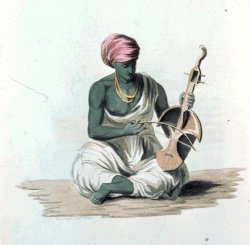Sarinda (instrument)
This article includes a list of references, related reading or external links, but its sources remain unclear because it lacks inline citations. |
 | |
| Template:Infobox instrument/Classification | |
|---|---|
| Classification | Bowed string instrument |
| Related instruments | |
| Sarangi | |
A sarinda or saranda is a North Indian stringed folk musical instrument similar to lutes or fiddles. It is played with a bow and has between ten and thirty strings. The bottom part of the front of its hollow wooden soundbox is covered with animal skin. It is played while sitting on the ground in a vertical orientation.
The Sarangi and Nepali sarangi are similar to the Saranda. The Bodos call it Serja or Serenja.
Several ethnic groups of India, e.g. Bauls of Bengal, Punjabi people, the folk artists of Rajasthan, the Bodo of Assam, and the related Twiprasa of Tripura , use the sarinda in their traditional music and dance. It is the sole accompaniment for a soloist or group folk singer(s).
See also[edit]
- Sarangi - a more common relative of the sarinda.
- Sarangi (Nepali) - a simpler version of the sarangi, played in Nepal and Sikkim.

